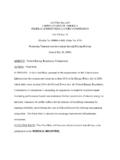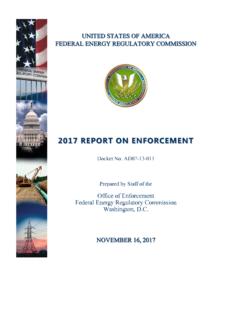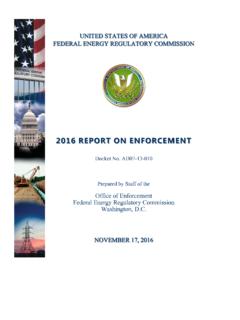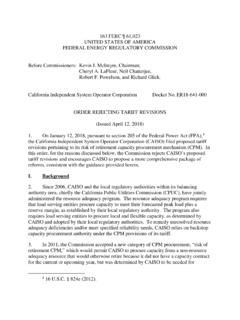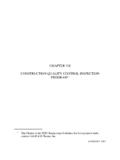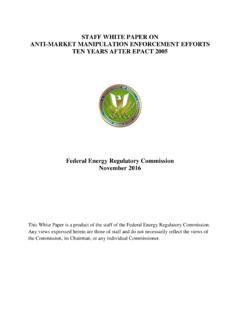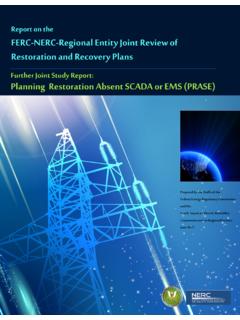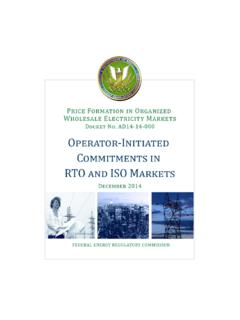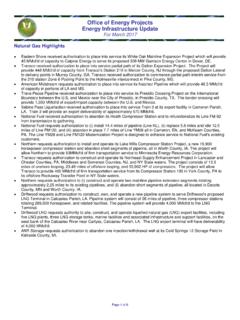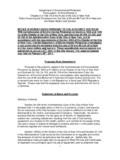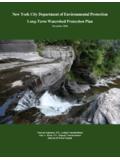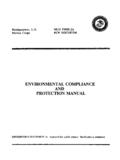Transcription of UNITED STATES ARMY CORPS OF ENGINEERS …
1 MEMORANDUM OF UNDERSTANDING. Between UNITED STATES army CORPS OF ENGINEERS . And THE federal energy regulatory commission . On NON- federal HYDROPOWER PROJECTS. The UNITED STATES army CORPS of ENGINEERS ( CORPS ) and the federal energy regulatory commission ( commission ), as parties to this Memorandum of Understanding (MOU), hereby acknowledge and declare as follows: I. Introduction In the interest of mutual cooperation for facilitating non- federal hydropower development, the commission and the CORPS developed this Memorandum of Understanding to coordinate the respective regulatory processes associated with the authorizations required to construct and operate non- federal hydropower projects. II. Purpose The purpose of this MOU is to establish a framework for early coordination and participation among the signatories to this agreement to ensure the timely review of and action on proposed non- federal hydropower development applications. Cooperation among the MOU signatories will ensure each agency's review and responsibilities under the National Environmental Policy Act (NEPA) and other related statutes are met in connection with the authorizations required to construct and operate hydropower facilities licensed by the commission .
2 The MOU signatories anticipate that the CORPS will act as a cooperating agency in most circumstances. However, there may be some circumstances where both agencies will be better served by a different form of coordination. This MOU. does not preclude such arrangements. III. Statutory Background A. National Environmental Policy Act of 1969 (42 4321 et seq.) requires all agencies of the federal Government to use a systematic, interdisciplinary approach which will insure the integrated use of the natural and social sciences in planning and decision-making which may have an impact on the environment. Prior to making any detailed statement, the responsible federal official shall consult with and obtain the comments of any federal agency which has jurisdiction by law or special expertise with respect to any environmental impact involved. 1. B. Section 10 of the Rivers and Harbors Act of 1899 (33 403) requires authorization from the Secretary of the army , acting through the CORPS , for the construction of any structure in or over any navigable water of the UNITED STATES .
3 Structures or work outside the limits defined for navigable waters of the UNITED STATES require a Section 10 permit if the structure or work affects the course, location, or condition of the water body. The law applies to any dredging or disposal of dredged materials, excavation, filling, re-channelization, or any other modification of a navigable water of the UNITED STATES , and applies to all structures, from the smallest floating dock to the largest commercial undertaking. It further includes, without limitation, any wharf, dolphin, weir, boom breakwater, jetty, groin, bank protection ( riprap, revetment, bulkhead), mooring structures such as pilings, aerial or sub-aqueous power transmission lines, intake or outfall pipes, permanently moored floating vessel, tunnel, artificial canal, boat ramp, aids to navigation, and any other permanent, or semi-permanent obstacle or obstruction. The CORPS ' Section 10 requirements for non- federal hydropower development are met through the commission 's licensing process.
4 C. Section 14 of the Rivers and Harbors Act (33 408) makes it illegal for anyone to occupy or alter a CORPS civil works project without express permission of the CORPS . Section 14 authorizes the Secretary of the army , on the recommendation of the Chief of ENGINEERS , to grant approval for the temporary occupation or use of any public works when the Secretary determines that such occupation or use will not be injurious to the public interest. Provided further, the Secretary may, on the recommendation of the Chief of ENGINEERS , grant approval for the alteration or permanent occupation or use of any public works when, in the judgment of the Secretary, such operation or use will not be injurious to the public interest and will not impair the usefulness of the public work. The authority to approve projects has been delegated from the Secretary of the army to the Chief of ENGINEERS . D. Section 404 of the Clean Water Act (33 1344) requires authorization from the Secretary of the army , acting through the CORPS , for the discharge of dredged or fill material into all waters of the UNITED STATES , including wetlands.
5 Discharges of fill material generally include, without limitation: placement of fill that is necessary for the construction of any structure, or impoundment requiring rock, sand, dirt, or other material for its construction; site-development fills for recreational, industrial, commercial, residential, and other uses; causeways or road fills ; dams and dikes; artificial islands ; property protection or reclamation devices such as riprap, groins, seawalls, breakwaters, and revetments; beach nourishment; levees; fill for intake and outfall pipes and sub- aqueous utility lines; fill associated with the creation of ponds; and any other work involving the discharge of fill or dredged material. A CORPS permit is required whether the work is permanent or temporary. Examples of temporary discharges include dewatering 2. of dredged material prior to final disposal, and temporary fills for access roadways, cofferdams, storage, and work areas. E. Section 103 of the Marine Protection, Research, and Sanctuaries Act of 1972.
6 (33 1413), as amended, requires authorization from the Secretary of the army , acting through the CORPS , for the transportation of dredged material for the pm;pose of dumping it in ocean waters. Discharges of dredged or fill materials into territorial seas also requires authorization under Section 404 of the Clean Water Act (CWA). F. federal Power Act (16 791, et seq.) authorizes the commission to issue preliminary permits and licenses under Part I for non- federal hydropower projects, including those utilizing CORPS facilities. The commission considers applications from potential project developers for preliminary permits, which, upon issuance, give the permittee the right to priority of application for a license while the permittee obtains data and performs feasibility studies. In addition, before applicants can apply for a license, the commission requires the applicant to participate in a rigorous pre-filing process. Prior to issuing a decision on a license application, the commission conducts environmental, dam safety, public safety, and security reviews of hydropower projects and related facilities , including primary transmission lines, and as the lead federal agency prepares the overall NEPA documentation (18 Part 380).
7 In conjunction with the NEPA review, the commission performs a detailed review of the environmental effects and reasonable alternatives to the proposed project, including appropriate mitigation and enhancement measures. A summary of that review, including conclusions and recommendations, is included in the NEPA document. The commission can impose requirements in any license issued to ensure the safety and security of, and protect navigation affected by, projects within its jurisdiction. During construction of the hydropower facilities , the commission conducts periodic inspections to ensure compliance with conditions attached to the license and to ensure the constructed water retaining features of the project meet the commission 's Division Dam Safety and Inspections Engineering Guidelines. Once the project is in operation, the commission conducts inspections of the project, which focuses on equipment, operation, dam safety, public safety and compliance with license requirements, including environmental measures.
8 IV. Roles and Responsibilities A. The federal energy regulatory commission : The commission issues preliminary permits and licenses to non- federal entities for the development of hydropower projects under its jurisdiction, including projects utilizing federal 3. dams or other federal facilities where Congress has not authorized power development as a project purpose. B. army CORPS of ENGINEERS : The CORPS has constructed water resources projects throughout the Nation where a potential exists for the development of hydropower energy . The CORPS can allow the development ofhydropower by non- federal entities at suitable projects, provided that the installation and operation of the hydropower facility is found to be compatible with the purposes for which Congress authorized the project and would not be injurious to the public interest, and provided that there is no federal interest in developing hydropower at the facility. 1. The CORPS evaluates requests for the temporary or permanent modifications of its projects under Section 14 of the Rivers and Harbors Act of 1899 (33.)
9 C. 408) through information provided by the developer to the CORPS District responsible for the project at which hydropower development is under consideration. Final approval of the request rests with the Director of Civil Works. To the maximum extent practicable, the CORPS will use the design and environmental information the developer has provided to the commission for jts license process. 2. The CORPS administers a regulatory program to protect the Nation's aquatic resources, including wetlands, under Sections 9 and 10 of the Rivers and Harbors Act of 1899 and Section 404 of the Clean Water Act. Proposed non- F ederal hydropower plants may require one or more permits and/or approvals from the CORPS under these statutes. The CORPS ' Section 10 requirements for non- federal hydropower development are met through the commission ' s licensing process. V. NEPA Lead federal Agency. NEPA is the overarching environmental statute requiring the identification of impacts to the quality of the human environment, consideration of alternatives, and public involvement in the process.
10 A primary objective of NEPA is to ensure that environmental information is available to public officials and citizens before irretrievable commitments of resources are made. This agreement supports these principles, and the signatory federal agencies acknowledge their respective responsibilities for complying with the requirements of NEPA. To prevent the duplication of efforts by federal agencies and encourage information sharing and integration of agency processes, NEPA allows for the designation of a lead federal 4. agency for environmental documentation. Other agencies that have authorities related to 1. the same project may serve as cooperating agencies on the environmental document. As the agency with the approval/disapproval authority for the licensing of hydropower projects, the commission shall serve as the lead federal agency for the preparation of the environmental document. This MOU encourages early involvement between the commission and the CORPS , and among public and other government agencies during the pre-filing stage oflicensing and the NEPA evaluation process.
